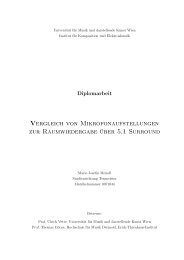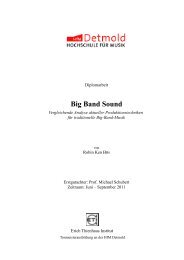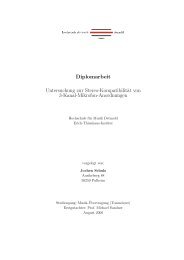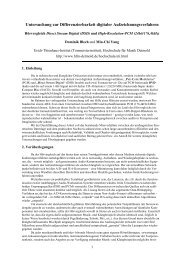Directivity measurement of a singer - Harald Jers
Directivity measurement of a singer - Harald Jers
Directivity measurement of a singer - Harald Jers
You also want an ePaper? Increase the reach of your titles
YUMPU automatically turns print PDFs into web optimized ePapers that Google loves.
<strong>Directivity</strong> <strong>measurement</strong> <strong>of</strong> a <strong>singer</strong><br />
Malte Kob, <strong>Harald</strong> <strong>Jers</strong>; Inst. <strong>of</strong> Technical Acoustics, Technical University Aachen,<br />
Templergraben 55, D-52056 Aachen, Germany, E-mail: kob@akustik.rwth-aachen.de<br />
Published in: Collected Papers from the Joint Meeting “Berlin 99”, ISBN 3-9804568-5-4<br />
1 Introduction<br />
For accurate room acoustical simulations, it is necessary to have a good knowledge <strong>of</strong><br />
the radiation properties <strong>of</strong> the sound sources. Within a larger project [Je, JeKo], the radiation<br />
properties <strong>of</strong> a <strong>singer</strong> have been investigated and an artificial <strong>singer</strong> has been<br />
constructed to accurately reproduce the human voice. A new <strong>measurement</strong> method has<br />
been applied, because the non-stationary character <strong>of</strong> the voice does not allow for<br />
<strong>measurement</strong>s with one scanning microphone as used in the <strong>measurement</strong>s <strong>of</strong> e.g.<br />
loudspeakers.<br />
2 Properties <strong>of</strong> the human voice<br />
For the calculation <strong>of</strong> the directivity, a stationary, broadband signal is quite helpful. Unfortunately,<br />
the human voice varies quite strongly in both, amplitude and frequency<br />
distribution during pronunciation <strong>of</strong> e.g. a vowel. Additionally, the harmonic nature <strong>of</strong><br />
the singing voice yields a rather discrete distribution <strong>of</strong> the sound energy.<br />
The Fourier transform <strong>of</strong> a voice sample<br />
(picture to the right) shows the spectrum <strong>of</strong><br />
the sung vowel “o“. The energy is concentrated<br />
in the peaks from approx. 100 Hz up<br />
to about 5 kHz. The gaps between the<br />
peaks make it impossible to derive a directivity<br />
at these frequencies.<br />
3 Measurement principle<br />
A solution to this problem is to have the<br />
<strong>singer</strong> sing a glissando - i.e. a vowel with<br />
increasing pitch. The Fourier transform <strong>of</strong><br />
this signal will contain energy from the<br />
lowest to the highest harmonics.<br />
To the right, the spectrum <strong>of</strong> the swept<br />
vowel “o“ is shown, sung from a bass<br />
<strong>singer</strong> from the lowest possible pitch<br />
throughout one octave.<br />
The level fluctuations <strong>of</strong> the singing voice<br />
can be compensated with a reference signal<br />
from a second microphone as described in<br />
the <strong>measurement</strong> set-up.<br />
2aMU19
4 Measurement set-up<br />
For the <strong>measurement</strong> procedure, the <strong>singer</strong> stands on a turntable (see pictures below).<br />
Microphone beam<br />
M 2 M 1<br />
To the left, the<br />
<strong>measurement</strong> setup<br />
is sketched. The<br />
signal processing is<br />
performed within<br />
the computerbased<br />
s<strong>of</strong>tware<br />
“Monkey Forest”<br />
(MF).<br />
Turnt able<br />
Frontend<br />
Amplifier<br />
PC + MF<br />
On the right, a<br />
photo from the<br />
<strong>measurement</strong> <strong>of</strong> a<br />
<strong>singer</strong>’s directivity<br />
is shown.<br />
The reference microphone (M2) is taped to his or her nose and records the sound pressure<br />
near the mouth. The other microphone (M1) records the sound pressure at fixed<br />
distance from the <strong>singer</strong>’s mouth. The energy ratio <strong>of</strong> the spectra<br />
S<br />
Srel ( f ) =<br />
S<br />
M 1<br />
M 2<br />
( f )<br />
( f )<br />
does not depend on amplitude fluctuations <strong>of</strong> the source signal, provided that the signals<br />
contain enough energy.<br />
The ratio can be normalised to an average sound pressure level at M1 which can be<br />
moved along a beam that accommodates directivity <strong>measurement</strong>s from -40° to +90°<br />
elevation.<br />
5 Compensation for the microphone position<br />
Due to the microphone‘s close position to the mouth and the head, an equalisation <strong>of</strong><br />
the stationary spectrum recorded by M2 has to be performed. For this purpose, the artificial<br />
<strong>singer</strong> (described in the lower left part) was equipped with the nose microphone<br />
and was fed a “pre-whitened” signal that yielded a flat spectrum at a two meter distance.<br />
On the left, the set-up for the<br />
<strong>measurement</strong> <strong>of</strong> the compensation<br />
spectrum is shown.<br />
To the right, the spectrum <strong>of</strong> the<br />
signal from the nose microphone<br />
recording is plotted. The correction<br />
for the level loss was applied during<br />
internal processing <strong>of</strong> the signals,<br />
within the <strong>measurement</strong> program.<br />
dB<br />
10<br />
0<br />
-10<br />
-20<br />
0.01 0.1 1 10kHz
6 The artificial <strong>singer</strong><br />
The purpose <strong>of</strong> constructing an artificial <strong>singer</strong> is to achieve natural reproduction <strong>of</strong> the<br />
human voice with regard to both the frequency behaviour and the radiation properties.<br />
Preliminary investigations on a simple cylinder-shaped artificial speaker revealed insufficient<br />
sound power due to the limitations <strong>of</strong> the small loudspeaker as well as a radiation<br />
characteristic that lacks the details <strong>of</strong> a real <strong>singer</strong>’s directivity. In close cooperation<br />
with the workshops at ITA, a human-like artificial <strong>singer</strong> was constructed<br />
that meets the requirements for the reproduction <strong>of</strong> a loud human voice.<br />
Technical properties<br />
• shape equals the ITA dummy head ⇒ natural diffraction<br />
• one midrange loudspeaker (TPC 80 RW/4h) for the radiation<br />
through the mouth with<br />
• guided airflow from loudspeaker to mouth to avoid<br />
standing waves<br />
• two low-range speakers (Fane Studio 5M) with as a 4thorder<br />
symmetric bandpass system for the bass-voice reproduction<br />
• opening <strong>of</strong> the bass reflex tube in the neck<br />
• transition frequency between midrange and bass system:<br />
150 Hz<br />
• equalisation <strong>of</strong> the frequency response for both channels<br />
separately with the digital controller HUGO ® [JK]<br />
To the left, the interior <strong>of</strong> the artificial <strong>singer</strong> is shown.<br />
The two bass speakers can be seen, as well as the bass<br />
reflex tube. The head is formed from a gypsum form and<br />
consists <strong>of</strong> polyester. The upper part <strong>of</strong> the torso is made<br />
<strong>of</strong> seven handcrafted pieces <strong>of</strong> wood.<br />
The plot to the right indicates the frequency responses<br />
<strong>of</strong> the installed midrange (red) and the<br />
bass loudspeaker (green) as well as the curve for<br />
the equalised <strong>singer</strong> (blue). The high and constant<br />
level that can be achieved with the equalised<br />
system extends 80 dB from below 70 Hz and allows<br />
reproduction <strong>of</strong> soprano to bass singing<br />
voices.<br />
Subjective listening tests confirmed the realism <strong>of</strong><br />
(1) the head’s voice and (2) using measured impulse<br />
responses <strong>of</strong> the voice in choir auralisations<br />
[JeKo].<br />
Lp [dB]<br />
120<br />
100<br />
80<br />
60<br />
40<br />
10 100 1000 10k f [Hz]<br />
7 <strong>Directivity</strong> plots<br />
The directivity plots presented below depict the radiation properties <strong>of</strong> a female <strong>singer</strong>,<br />
compared to the radiation <strong>of</strong> the artificial <strong>singer</strong>. The ratio <strong>of</strong> the signals has been corrected<br />
for the microphone position and averaged in one third-octave bands. The levels<br />
are normalised to the value <strong>of</strong> the 0° elevation and 0° azimuth (arrow). The pictures on
the left show the directivity seen from the right front <strong>of</strong> the artificial <strong>singer</strong> (upper row)<br />
and <strong>of</strong> a female <strong>singer</strong> (lower row). They are in good agreement with former <strong>measurement</strong>s<br />
[MeMa].<br />
250 Hz 2500 Hz 4000 Hz Level 2500 Hz (seen from back)<br />
artificial<br />
<strong>singer</strong><br />
female<br />
<strong>singer</strong><br />
8 Uncertainty <strong>of</strong> the <strong>measurement</strong>s<br />
One source <strong>of</strong> <strong>measurement</strong> errors is the repeatability due to changing distance from<br />
the <strong>singer</strong>’s position to the microphone M1. The following graphs indicate the <strong>measurement</strong><br />
error. The maximum error out <strong>of</strong> 10 <strong>measurement</strong>s is plotted vs. frequency.<br />
The graphs indicate the<br />
dB<br />
dB<br />
10<br />
error for 0° azimuth (left 10<br />
figure), and for 180°<br />
5<br />
5<br />
azimuth (right figure).<br />
0<br />
The cause <strong>of</strong> the increasing<br />
0<br />
-5<br />
error is the in-<br />
sufficient energy content<br />
-5<br />
60 100 1000 5000 Hz <strong>of</strong> the voice at high frequencies.<br />
60 100 1000 5000 Hz<br />
9 Conclusions<br />
The method presented above allows for accurate and reproducible <strong>measurement</strong>s <strong>of</strong> the<br />
directivity <strong>of</strong> non-stationary sound sources. Thanks to the simple <strong>measurement</strong> procedure,<br />
the radiation characteristics <strong>of</strong> different <strong>singer</strong>s can been studied in detail. The<br />
results obtained so far indicate a good agreement between directivity <strong>measurement</strong>s on<br />
human <strong>singer</strong>s and the artificial <strong>singer</strong> and reveal interesting interference patterns that<br />
have not been measured before. This method could also be applied to directivity <strong>measurement</strong>s<br />
<strong>of</strong> musical instruments.<br />
10 Literature<br />
[MeMa] Meyer J., A. H. Marshall: Schallabstrahlung und Gehörseindruck beim Sänger, 13. Tonmeistertagungsbericht<br />
München, 1984, Verlag Saur München VDT<br />
[Je] <strong>Jers</strong>, H.: Untersuchung der Realisierungsmöglichkeiten verteilter Quellen für die raumakustische Computersimulation<br />
am Beispiel des Chores, Diplomarbeit, Institut für Technische Akustik, RWTH Aachen,<br />
1998<br />
[JeKo] <strong>Jers</strong>, H., Kob, M.: Nachbildung eines Chores für raumakustische und musikalische Untersuchungen, 20.<br />
Tonmeistertagungsbericht Karlsruhe, 1998, Verlag Saur München VDT<br />
[JK] Kleber J.: Development <strong>of</strong> a multiprocessor system (HUGO) for acoustic applications, 2 nd Forum Acusticum,<br />
Berlin 1999, (pres. 5aSPa12)





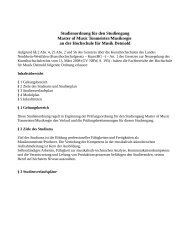


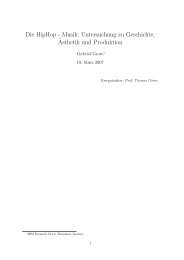
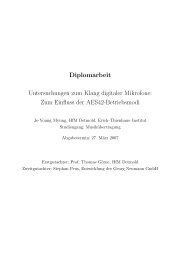
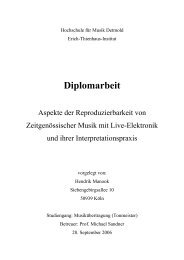

![[Teil 3] Hörversuch - Erich-Thienhaus-Institut - Hochschule für Musik ...](https://img.yumpu.com/7220535/1/184x260/teil-3-horversuch-erich-thienhaus-institut-hochschule-fur-musik-.jpg?quality=85)
